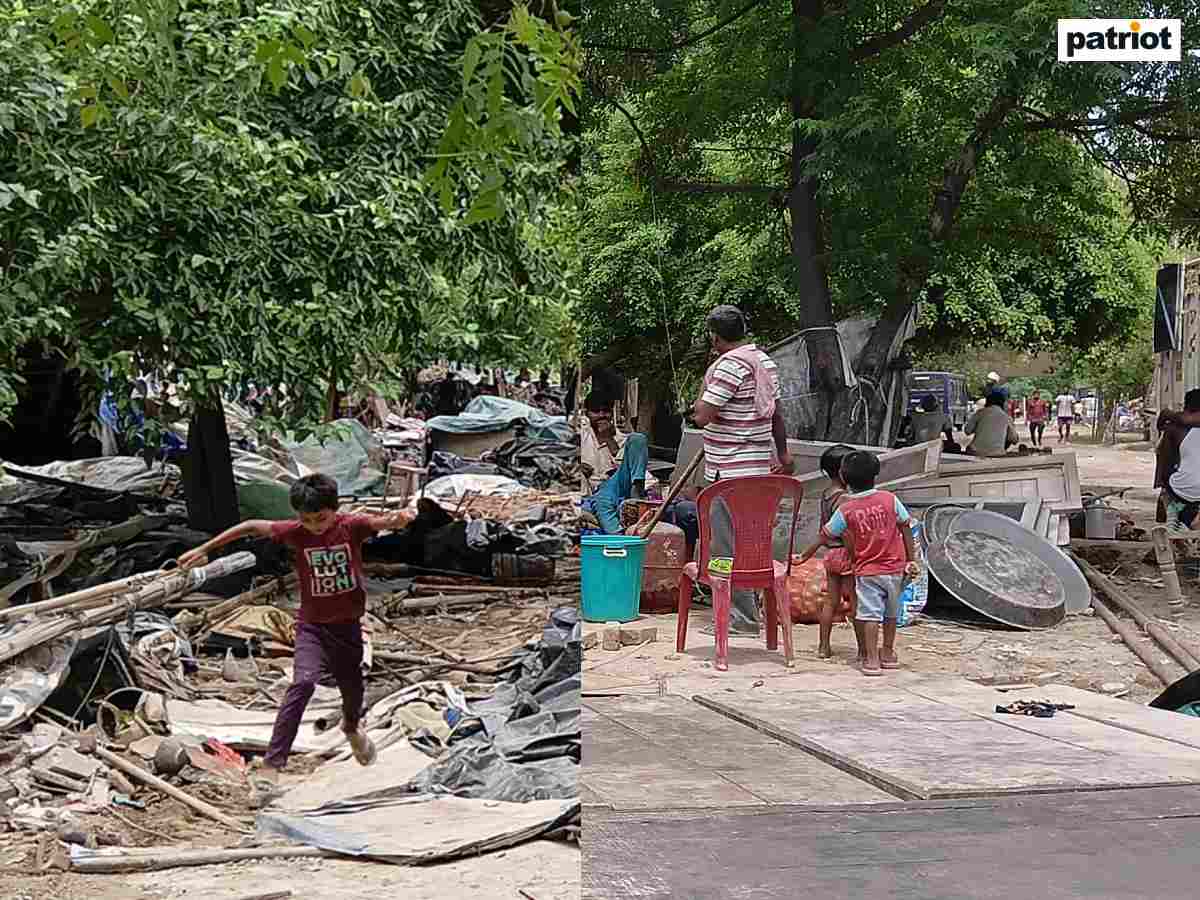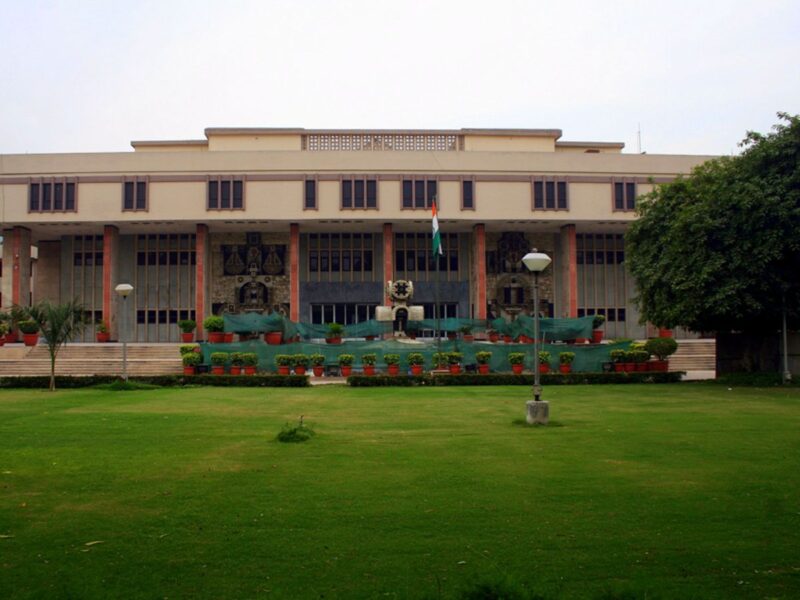Delhi: The 15,000-Odd residents of the Yamuna floodplains woke up on July 5 to a rude shock as 10 bulldozers flocked to the cluster of temporary tenements to go on a spree of demolitions through the extent of Pusta Road.
Amid the clutter, a wedding was being held while another funeral was being consummated a few steps away from the rubble.
What was set to be an auspicious day for 19-year-old Neha, turned into a tragic tale of celebration. Her groom, a resident of Wazirabad, made his presence felt in the evening. However, with the demolition that went about at the settlement, all that remained of the wedding tent were four metal poles and a stack of chairs laid on top of each other. The security personnel had torn the cloth canopy down.
“This has turned into the worst day of my life. This is no atmosphere to get married at. I have just turned homeless,” said Neha as she tapped her fingers on her mehendi-laden forearm.
All unregistered settlements are being removed. The entirety of the settlement along the Pusta Road ranging from Mayur Vihar Phase-1 to the Yamuna River Bridge near Sarai Kale Khan, were destined to the fate of bulldozers on July 5.
Early Shock For Residents
At 5:30 AM, a rally of bulldozers huddled up to the settlement at the base of the floodplain where a settlement of 15,000 residents lived and thrived for the past 20 years. Presently, all that remains of the settlement is debris from the tarpaulins that sheltered the residents and the single strand of hope they had of survival. However, now with Delhi having faced a long swathe of heavy rainfall and heavier rainfall to come, the residents have but themselves to fend for.
Narender Saket, 30, a resident of the settlement, said that the entire scenario unfolded in the early hours of the morning when most people were asleep.
“We were not prepared for what was to unfold. We thought that they would give us some time to pack our things and leave but we did not get any time. I thought that they would show some amount of mercy to us but nothing of that sort happened,” he said.
The residents at the settlement were provided with a notice stating the demolition of their houses owing to the entire area being under the ownership of the Delhi Development Authority (DDA) by the order of the Delhi HC.
The notice was produced before them on Thursday evening, July 4, and they were asked to evacuate by Friday, July 5. The authorities began demolishing the houses on the morning of July 5.
The settlement proved host to many people, with most hailing from districts in Uttar Pradesh and Bihar. All of them were either engaged in daily wage work or farming.
However, the yield since the floods that had ravaged the national capital had made it fairly difficult to farm, yet, none of them was provided any aid from the authorities or the government. Presently, most of the farmlands have resorted to growing okra. The heavy rainfall this year had destroyed the other crops.
The floodplains are stretched out on either side of the River Yamuna, along its 22km long course, housing multiple clusters of unregistered slums and settlements, with multiple permanent concrete structures built atop it.
However, every other year, some settlement or the other along the banks of the river gets demolished, in lieu of a High Court order passed in April which directed the removal of all settlements along the Yamuna floodplain. According to a report, in 2022, the banks of the river housed 9,350 households with 46,750 people.
Also read: Balban Tomb, Jamali Kamali monuments to undergo complete restoration this year
Govind, 24, and his mother, Meena, 42, had been managing their farmland for the past 20 years alongside Govind’s uncle who breathed his last on the day. The yield from the farm, spanning an acre, was enough to sustain the family but the rainfall had changed the course of the family’s sustenance.
“Normally, we would use the crops that we grow here for our family and also, sell it in the market. However, with the incessant rainfall alongwith the floods last year, we have not seen a morsel of money. It is because of the rainfall that all of the other crops are dead in our farm now. I do not know why the authorities are choosing to punish the poor now,” said Govind.
According to him, the family used to grow various kinds of spinach, brinjal, cabbage, bottle gourd and sponge gourd, among other vegetables.
“The only crop that is growing right now is okra. Nothing else survived the rainfall,” said Meena.
According to the India Meteorological Department (IMD), the national capital bore witness to 228.1 mm of rainfall in 24 hours till Friday, June 28. It was the highest in the city since 1936.
However, during the course of the rains, the residents of the Yamuna floodplains region found no refuge from either the Aam Aadmi Party-led state government or the National Democratic Alliance-led Centre. In 2023, all of the residents had to be shifted to the wayside after the Yamuna breached the danger mark of 205.44m and reached a record high of 208.48m, as the entire area was flooded, destroying crops and livelihood whichever lay bare in its path.
As more rain awaits Delhi, the residents have been left to fend for themselves as they remain afraid of leaving the settlement without taking their belongings even if it is to protect themselves.
“Even when it rained this time around, we had to take shelter under the flyover since a part of our cluster was fully submerged in water. We thought that the government would help us later but they came only to break our houses down. At this point, even if it rains later, I will not move from here. Otherwise, the police personnel will not let me return,” said Vipin, 26.
According to residents, the demolition was overseen by the Delhi Police, multiple paramilitary forces, alongside the DDA.
Many of the residents were apprehensive of the judiciary’s decision, stating that they did not have enough resources to appeal against the Delhi HC’s decision.
“We thought that the judiciary would help the poor like us, but justice is only served to the rich. No government will call upon the Delhi Secretariat or the rich people at Sainik Farms even their residences are illegal,” said Adesh Saxena, 36.
The National Green Tribunal had ruled that all farming-related activities along the floodplains had to be halted because of possible water pollution in Yamuna, following which the land was acquired by the DDA in 2015.
Also read: Delhi: Cases of drunk driving, minors steering vehicles see an uptick this year





